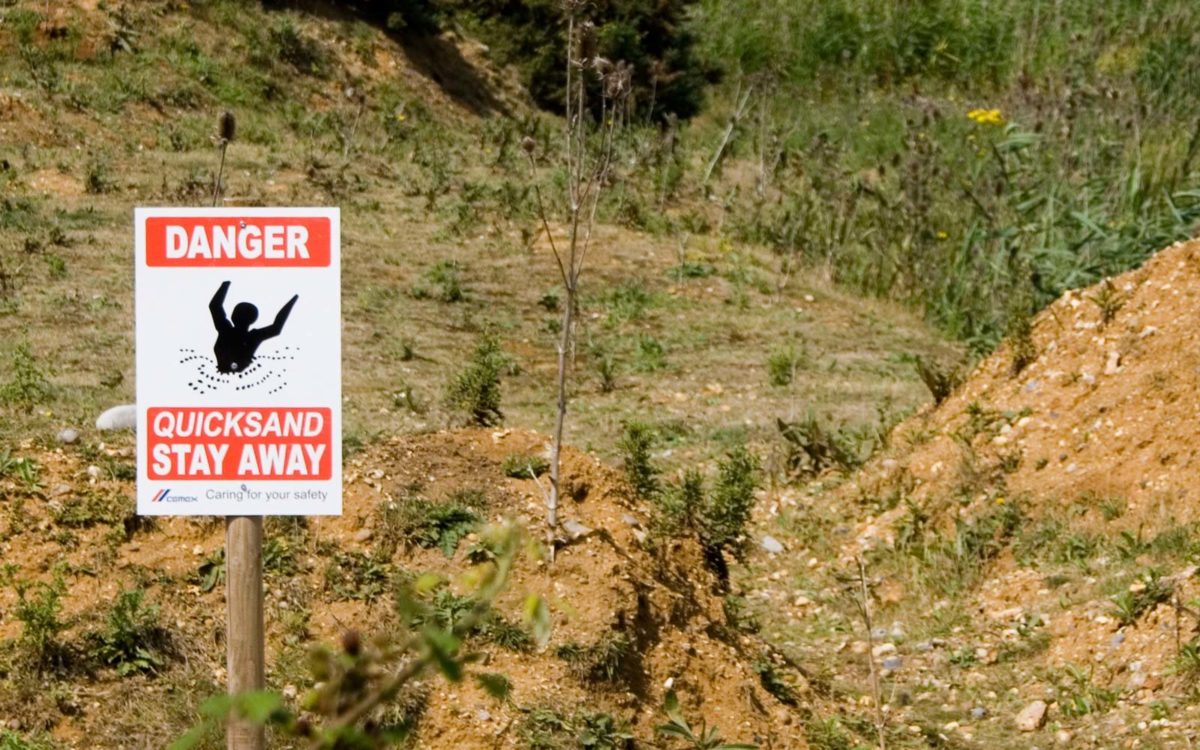
Probably every Hollywoodian adventure flick out there has at least one scene where the protagonist or, better yet, the bad guy, finds himself trapped in quicksand. Film producers gave their very best to depict as gruesomely as possible what it means to become entangled in that sandy pit of death.
I have to admit that, for a very long time, I was convinced that there was no difference between stepping in quicksand and doing the mamba in a minefield. Although most of the things you see in movies are BS, not all are fictitious.
For instance, I remember seeing a screen adaption of The Hound of Baskerville, my favorite story from the Sherlock Holmes universe, in which one the main characters explain to doctor Watson how people may ‘unstuck’ themselves from quicksand by getting on their backs and swim. True to some degree, as you will find out later in this chapter, but not nearly enough to get out of quicksand.

A billboard advertising a book? DETAILS HERE
When it comes to movie depictions of shifting sands, the thing that irks me the most is this feeling of utter doom given off by those scenes. It’s something like “Crap! I stepped in quicksand. Well, nothing more to do than letting the sands swallow. Oh, to make things even more dramatic, I will roar like a raging lunatic and flutter my arms. That’s it! Lights out! Buh-bye! End of the line for me.”
It’s not exactly like that in real life. Sure, if you move around like crazy, that thing will eventually choke on sand or mud. That’s another thing – quicksand pits are not always made of sand, and it’s not just desert you’ve got to look out for.
Technically, any hole containing a fair amount of sand, dirt, silt or clay can become a quicksand pit it’s drenched by water and agitated by movement. I won’t bore you to death with the science behind quicksand, but I will say this – these treacherous pits can be found anywhere around the world, especially in areas that have been hit by natural disasters such as earthquakes, landslides, and flooding.
So, my advice to you is to watch your step and stay away from puddles or suspicious pits. Carrying a walking stick always helps, especially when you have to traverse unknown terrain. As you’re walking, the ground in front of you with your stick a couple of times. If it appears to be solid, it means it’s safe to walk.
Still, if the end gets caught and you have trouble getting it out, you should definitely avoid the area. That’s basically it for the prepping and prevention part. Let’s now see what we should do in case we end up in a quicksand pit.
Step 1. Stop and discard.
Once you step in a quicksand pit, you’ll immediately notice that your body will slowly begin to plunge in the pit. Stop! Take a deep breath! You’re not going to die here. Now, the first thing you’ll need to concern yourself with is your weights – the heavier you are, the faster you’ll sink.
So, grab your backpack and throw it as far away from the quicksand pit as possible. If you have a toolbelt or anything similar, you should throw that away as well. Your boots make one Hell of a difference when it comes to getting out fast of quicksand. For instance, rubber boots, like those used by people fishing in shallow waters, are very useful for this kind of situation since they can be removed easier compared to their laced peers.
Step 2. Watch your movements
The whole idea of dealing with quicksand is knowing exactly when to move and when to stand still. What most people don’t know is that there’s a 5 to the 10-second interval which allows a quick escape. So, if you step in one of these quicksand pits, go through step one, which is discarding your backpack and any other stuff that might weigh you down, and try to take a couple of steps forward and backward.
Small, baby steps – don’t try to rush things. If you move slowly, you’ll soon feel that less grip. Continue doing this until you manage to break free of the quicksand pit.
Step 3. Drop and swim to safety
If you miss this interval, again, stop what you are doing, stand still, and take a deep breath. Remember that every twitch or sudden movement can stir the stuff inside the pit. This will tighten the grip and make you sink even further.
Once you’ve calmed down, slowly lay on your back, just as you would do at a hospital when a nice lady doctor offers you a consultation. Keep your arms parallel to your body. You should ensure that your head and torso remain above the ground. Take a short breather, and roll on one side. Now, arch your back and swim forward. Remember the backstrokes you’ve learned in swimming class? That’s exactly what you must need to do.
The only difference between swimming in water and quicksand is the amount of friction. Obviously, it’s more challenging to swim in mud or sand compared to water, but if you put your back into it, you’ll eventually reach solid ground.
Again, everything must be done in slow motion. Don’t rush it! If you feel that the effort’s too much, rest for a couple of minutes. Yes, I know it’s frustrating to have the same speed as a garden snail, but rushing it would only make you sink even further into the quicksand.
Once you feel that the ground below you is solid, flop back, firmly plant your hands on the ground, and push as hard as you can to yank yourself loose.
Don’t worry about losing your boots or smartphone in the quicksand pit. Those can be replaced; your life cannot. Above all, don’t try sticking your hand inside the hole in a desperate attempt to recover your position. Your priority right now would be to recover your B.O.B and\or toolbelt.
Do a quick inventory to see if anything went missing. If you have an emergency phone in your backpack, use it to call the authorities. You can also switch on your personal emergency beacon if you have one.
The next step would be to check all body areas that have been in contact with the quicksand pit. Remember that the extra friction may cause some nasty bruises and even wounds. If this is the case, get the first-kit out of your bug out bag and treat all resulting wounds before infection sets in.
Additional considerations on surviving quicksand pits
In 99.9 percent of cases, you can survive a quicksand encounter. Still, there are a couple of more things you should know about these things.
Quicksand pits are not specific to only one part of the world.
In fact, research has pointed out that these formations can appear anywhere in the world, especially in proximity to bodies of water such as lakes, underground springs, riverbanks, beaches, and marshes.
Quicksand pits are featureless.
There’s no possible way of telling if the thing in front of you is a quicksand pit or just another mud puddle or hole in the sand. Well, there actually is – by getting stuck in it!
Swimming is the best way to get out of quicksand.
Buoyancy is the only thing that keeps you from meeting an untimely demise. However, there are times when you may not be able to backstroke your way out of a quicksand pit. More specifically, the friction will be too higher for your body. If this happens, arch your back and hips more. This will allow you to equally distribute your body weight, ensuring buoyancy.
Not all quicksand pits are dangerous.
Although movies show that each encounter with a quicksand pit means certain death, in reality, you won’t sink lower than your ankles. Still, you shouldn’t take this for granted, since everything depends on how deep the pit’s in the first place.
Panicking is the leading cause of death in case of deep quicksand pits encounters.
Researchers have determined that most people who have choked to death in shifting sands, panicked and tried to latch onto anything they could find.
Remember that sudden and violent movement will only stir the bottom of the pit even more which, as you’ve guessed it, results in sinking. Stay calm, lay flat on your back, flop over, and use the backstroke to get out of the quicksand pit.
Walking sticks makes escapes a lot easier.
Escaping a quicksand pit is a lengthy and strenuous process (sometimes, it takes more than half a day to cover one or two meters). You can reduce the time it takes you to get out by using your walking stick as a flotation device.
Provided that you haven’t lost the stick or threw away with your bug out bag and\or toolbelt, lay flat on your back and place the walking stick underneath your body (it should be right below the lumbar area). In a couple of seconds, you will notice that there’s no more sinking.
Using your legs only, push slowly. After advancing a couple of inches, move the stick to a new position. It will take a while, but by combining the leg-pushing drill with the stick, you’ll soon be able to reach firm ground.
That’s basically it for my take on how to escape a quicksand pit. Again, not all encounters with this sand and water formations area deadly. The odds are you’ll probably never sink below the ankle level.
For smaller quicksand pits, it’s enough to move your legs back and forth to get out. Of course, the best method of escaping quicksand pits is to avoid them in the first place. Granted that shifting sands are featureless, but you can test the terrain in front of you with your walking stick. Avoid marshy and sandy area also helps, but you never know where life takes you.
Other self-sufficiency and preparedness solutions recommended for you:
Healthy Soil + Healthy Plants = Healthy You
The vital self-sufficiency lessons our great grand-fathers left us
Knowledge to survive any medical crisis situation
Liberal’s hidden agenda: more than just your guns
Build yourself the only unlimited water source you’ll ever need
4 Important Forgotten Skills used by our Ancestors that can help you in any crisis






















